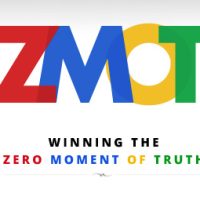In 2011, we introduced you to the Zero Moment of Truth, or ZMOT, which describes a revolution in the way consumers search for information online and make decisions about brands. Three years later, search and ZMOT have continued to grow in importance and scale, and as consumers’ behavior evolves, so must the ways in which brands engage those consumers. But in today’s always-connected, mobile-first world, how do brands win ZMOT? Here we share four tips for how to gain a competitive advantage.
Three years ago, we changed the marketing rulebook. And by “we,” I mean all consumers. Our shopping behavior—the journey each of us takes on our path to purchase—helped identify a new Moment of Truth for marketers and brands. ZMOT, or the Zero Moment of Truth, describes a revolution in the way consumers search for information online and make decisions about brands.
We saw that people are increasingly making these decisions at the Zero Moment—the precise moment when they have a need, intent or question they want answered online. These questions can be anything from “Which brand of diapers will help my baby sleep through the night?” to “What toothpaste is going to make my smile brighter?” or “What will remove crayon marks from my wood dining table?” A brand that answers these questions at just the right time scores a double win: It helps improve a consumer’s life and stands to gain a competitive advantage over brands that don’t.
That was 2011. Since then, the rulebook has changed—again.
There are more moments than ever
Search and ZMOT continue to grow in importance and scale. In the span of a single month, Google answers over 100 billion searches, according to internal data. So, in the few minutes it takes you to read this, there will be over 7.5 million searches on Google. Each of these searches presents a new opportunity to reach consumers when they’re most engaged.
ZMOT has become a truly global behavior When we first conducted our research, we were looking at U.S. consumers. Since then, we’ve seen the boundaries of ZMOT extend to every corner of the connected world, and not just for high-ticket items. In our latest study, Winning the Zero Moment of Truth in Asia, we saw that 78% of Asian women use search as a vital part of their decision process for consumer packaged goods (CPG) brands.
More moments are mobile
The ubiquity of smartphones means that ZMOT is no longer defined by a single discrete moment (“when I open my laptop and search”). Instead, it’s an integral part of the constantly connected consumer’s entire day. Search is always accessible—from anywhere, on any device and at any given time. In fact, approximately one-third of all CPG searches now originate from smartphones, according to Google Search data.
As consumers’ behavior has evolved, so must the ways in which brands engage them. In today’s always-connected, mobile-first world, how do you continue to win the Zero Moment of Truth? Here are four tips and questions to explore:
1. Use search to uncover and understand the moments that matter
Long before many brand managers even knew what they were, consumers were searching for things like “greek yogurt,” “BB cream,” and “ombre hair.” If you had to guess what kind of stain is searched for most, would you know the answer? Overwhelmingly, it’s “red wine stains.” Do you know what’s in the collective mind of consumers right now? (Answer: coconut oil). The trick is to use search to identify the moments that matter to consumers and act on them across your entire marketing mix.
2. Be present in the moments that matter
Woody Allen is often credited with saying, “Eighty percent of success is showing up.” This is especially true when it comes to digital. You can’t be a helpful brand partner and improve the lives of consumers if you’re not present in the moments they need you most. And increasingly, these moments are happening on smartphones. On mobile, do you know how many people are searching for your brand? Your category? How many of those times do you show up? How many times do they choose you, and why? Most importantly, how many times does your competitor show up, but you don’t?
3. Have something interesting, relevant and/or engaging to say
We’ve established that you need to have an answer to these many consumer moments, but do you have the “right” answer? And does your ad provide the best possible experience across screens? A search for “hairstyle” on, say, a Friday night probably means something different than it would on a Saturday morning (ideas for a quick hairdo for a night out vs. ideas for cuts for an upcoming salon appointment). Links to products may not be enough to hook consumers. Your ads should provide an experience that’s as informative and entertaining as possible: links to rich content on your website and opportunities to engage on Facebook or watch videos on YouTube, for example.
4. Measure the impact
You’ve managed to successfully capture the Zero Moment of Truth. Now what? To what degree does a ZMOT win advance business KPIs such as awareness, consideration, purchase intent, trial and repeat and purchase considerations? A new study from Google and Ipsos MediaCT, for example, shows that search ads drive brand awareness: The results reveal an average increase of 6.6 percentage points in top-of-mind awareness, from 8.2% to 14.8%—a lift of 80%.
Brands that are committed to the Zero Moment of Truth—the ones that use search to uncover and understand the moments that matter, that show up, that provide the right mobile-relevant answers and that measure the impact—stand to gain a competitive advantage. More importantly, they can help consumers when they need it most. At the end of the day, what matters more?
Jim Lecinski
Vice President, Americas Customer Solutions, Google
https://www.thinkwithgoogle.com/articles/zmot-why-it-matters-now-more-than-ever.html
Infobahn Consultancy – Leading online marketing in Dubai, UAE


